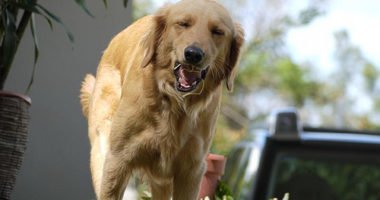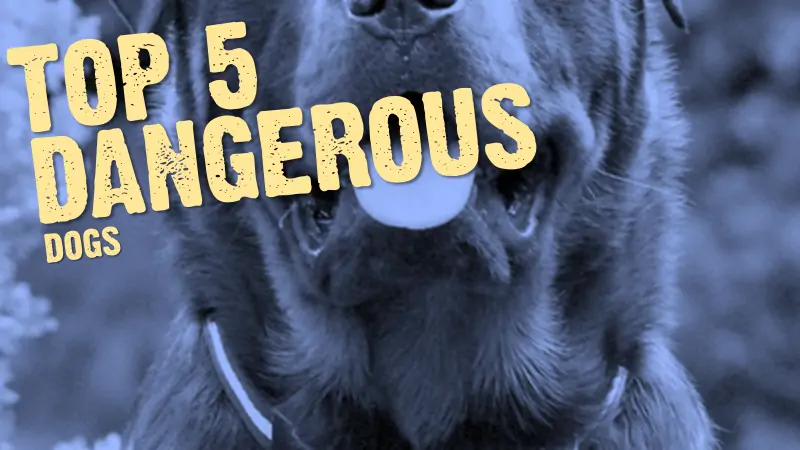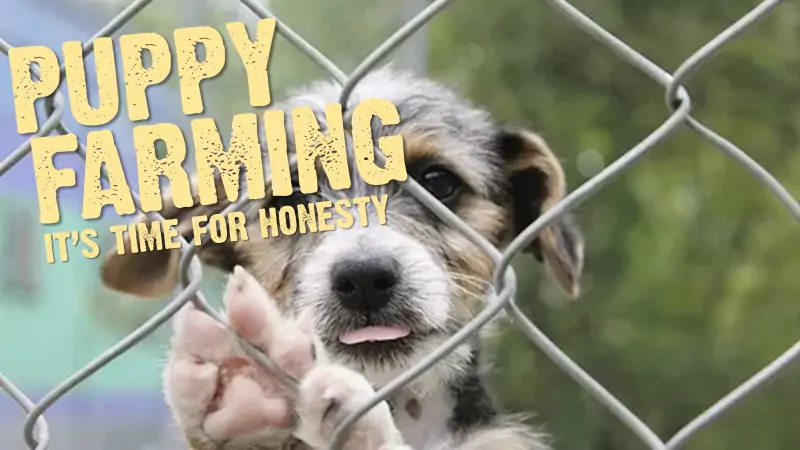Contents Show
So, you’d like to know how to stop your dog pulling on the lead?
Glorious summer days. The sounds of birds tweeting. Beautiful scenery all around….all completely overshadowed by the hound from hell dragging you at a pace you didn’t choose, in fact at a pace you can barely keep up with!
Taking the dog for a walk is supposed to be a joy but with the dog who pulls on the leads, it becomes more of a hand chaffing nightmare!
Let’s take a look at the steps we can take to learn how to stop a dog pulling on the lead.
Stop Dog Pulling: Leads, Collars & Getting The Right Equipment
Canine psychologist Natalka Jacyszyn – author of this report on ‘How to cure lead pulling in dogs‘ recommends using a flat collar and a nylon or rope lead, something that is comfortable for both you and your dog. Do not use an extending lead for training as you will find that you may not have enough control.

Getting the equipment right is as crucial as teaching the desirable heel walking position using positive rewards.
Having a dog that pulls is one thing, but having a dog that’s able to pull due to an owner using incorrect lead and collar set up is only going to make matters much, much worse.
Dog Leash Training: Using a Clicker to Cure Lead Pulling
Clickers are a fun and fast way to speed up your puppy’s learning process. Clicker training relies on behavior shaping principles that mark desired behavior.
With clicker training, timing is everything. You must capture the exact moment your dog is doing something right. Also start thinking in terms of stage-by-stage training. Let’s say I want to teach my dog to make a left circle. I sit with my dog and click when my dog takes one step to the left. That’s stage one. Then I hold out my click for two steps, then three, then a full circle.
Training this way definitely takes longer than pulling my dog in a circle, but once my dog figures out the sequence, he’s doing a circle with far more zest and enthusiasm than if I tugged him around and around.
The second secret of clicker training: Don’t attach a spoken command to behavior until your dog has figured out what is making the clicker work. To explain, think of the behavior Sit. Each time your dog sits, click and reward.
Getting the dog used to the concept of associating the click noise with a positive reward is how you achieve the best response when teaching the dog the desired behaviour to cure lead pulling problems.
Tip: You do not begin with the clicker on correcting the lead pulling until you have properly established the positive response reaction with the dog by rewarding small, simple behaviours – such as sitting and coming when called.
The Basics of Training Positive Behavior in Dogs
Training any new desired dog behaviour follows a simple six-step method. Depending on the dog and other circumstances, a good trainer will vary his training method when he decides that a particular training challenge needs either a little more or less. When you have used the method enough to know it well, you can add your own personal touch as needed.
The following are six steps for teaching your dog any new behaviour
1. Get the behaviour.
2. Mark the behaviour.
3. Reward the behaviour.
4. Repeat the behaviour until it happens easily at least 90{d4f4ff813a06e2c77cbb9c6effe011ebffe2f8986e44983e90e08c54deb62f63} of the time.
5. Add the verbal cue as your dog does the behaviour to associate the word with the appropriate response.
6. Use the verbal cue to elicit the behaviour.
You get the behaviour by capturing, shaping, or luring it. You mark the behaviour with the click., or some other reward marker that your dog has already learned means that the reward is coming. Reward the behaviour by following the click with his favorite treat or, in some cases, with a favorite toy or other desirable reward, such as swimming or going outside.
Repeat the behaviour until your pet is offering it easily before you add the verbal cue, so that he will associate the word with the correct behaviour response. For instance, by saying “Sit” as he does it, you are telling him that the name of the behaviour he is doing is Sit. If you ask him to do it before he’s offering the behaviour easily, you risk teaching him that the word sit means “stand there and look at me,” or worse, “sniff the ground and pull on the leash.”
After your dog has heard the word at least a half-dozen times during the behaviour, depending on how quickly he seems to learn, then you can say the word first to elicit the behaviour. Be sure that his attention is focused on you so that he actually hears the word, and keep your body position the same as it was when you were getting the behaviour before. If you had been doing the “Sit” while you were standing and you suddenly start asking for it while you are sitting, he won’t understand that it’s the same thing.
Give him a few seconds to respond. When he sits, click! and reward. If he doesn’t sit, use the minimum amount of assistance necessary (through body language or a lure, not through physical assistance) to get the behaviour, and repeat the exercise. If you find that he will only respond if you help him, start to minimize the amount of help you give until he is sitting for the verbal cue without any help from you.
Would a Harness Stop Dogs Pulling?
There are various styles of body harnesses is to choose from, but the majority of them have the basic metal D-ring which clips to the leash and is located on the strap that runs down the dog’s back. They can be used instead of collars which provide a much safer environment when the puppy tries to pull away.
In this regard, the puppy receives the tension from the leash, instead of his or her neck, which could result in a spinal injury. Puppies are specially prone to running and darting every chance they get, even when on-leash. By removing the pressure from the dog’s airway, body harnesses are a safe and effective alternative to standard neck collars.
If your dog is unresponsive when using a flat collar and lead – and still continues to pull – using a body harness or halter type set-up would be something to consider.
The Basic Principles of Correcting Dog Pulling / Any Other Behavior
Correcting the problem of a pulling dog is founded in two key principles that are universal to all dog training:
1. Reward the desired behavior (lavishly)
2. Do not reward the undesired behavior
Now, you may wonder what it means to ‘not reward undesirable behavior’ but first it’s important to understand that any response can be perceived as a reward by some dogs.
So if your dog is pulling and you respond by pulling back, for example, he may be treating this as a reward. He most certainly will if this process is just repeated over and over again.
You need to work in small steps. Teach him to always second guess the direction you are going to walk in and the moment he is by your side, reward him. The moment he steps out too far, change direction and do not reward him.
Be assertive and deliberate in your walking style. Do not let the dog lead the walk. If he pulls, you stop or go the other way.
Encourage him to understand that he will be rewarded ONLY for not pulling. The moment you feel ANY tension on the lead, stop and don’t say a word to the dog. This is a non reward. Seek to establish in his mind a positive association with a loose leash and the way he is walking.
If you have a problem with a dog who pulls on the lead, you can download K9 Magazine’s eBook ‘How to cure lead pulling in dogs ‘.
Bonus Dog Leash Training Guide: How to Train Your Dog to Walk on a Loose Leash
One of the biggest problems dog owners experience is out on the walk. The reason for this is due to the psychology of the pack needing a leader and more often than not, the dog thinks that he is it.
If the dog believes he is the leader then he believes he should be at the front of the pack and this is why you will see owners being pulled by their dogs.
Assessing the world through the dog’s eyes is paramount to helping him walk to heel. In order to change the dogs mind from pulling, we have to communicate in a gentle language he will understand.
The dog believing he is the leader believes it is his job to protect the pack and anything that approaches such as other dogs, joggers or cars could be perceived as a threat.
This creates all sorts of problems as the dog in a human ruled world will react to the threat in three ways: Flight, freeze and fight.
To help the dog stay calm in a world it does not understand, we have to switch roles and become the leader. When you achieve this, the dog will have no responsibilities and look to you to react at the potential dangers. To reverse roles and teach the dog to heel we have to go back to basics where the walk starts and identify and progress through the stages. As we complete a stage we can then move forward.
Firstly practice walking up and down the house with food reward encouraging your dog by your side rewarding him on a regular basis when he gets it right. As the dog understands where a good place to be is then you are ready to begin the first stage. The idea behind the stages is to start in a place where the dog feels comfortable with no distractions and build the foundations, as the dog improves you then slowly work up to a place with more distractions.
The first stage is calling the dog to you to put the lead on. In this scenario the dog may become over excited at the sight of the lead and jump up, run around, nudge or make noise. If the dog does react in an undesirable manner then put the lead down. Putting the lead on when the dog is in this state will only encourage pulling out on the walk. Repeat by picking the lead up again and putting down, until the dog becomes desensitised to the lead and reacts in a calm manner. When the dog is in a calm state you are ready to put the lead on and move to the next stage.
The second stage is putting the lead on and walking up and down the house once again encouraging your dog to the side you want him to be with food reward. If he gets it wrong we correct the mistake with a method called stop, start change direction. This method involves stopping when the dog drifts in front, encouraging him back to your chosen side, starting again when he is behind you, then changing direction. Repeating this method in the house lays the foundations for a good walk. Keep practicing and get it perfect in the house. If the dog does not listen to you in the house with no distractions, then he definitely will not listen to you outside with all the sights, smells and distractions.
Teaching a Dog To Walk to Heel
After teaching the dog to heel in the house you are ready to move to the third stage. The third stage is a place with more smells where the dog still feels safe like a garden, keep practicing stop, start, change direction, lots of praise, lots of food reward. If you haven’t got a garden, then choose a place outside with little distractions. Stay positive and dedicate a big space of time. Do not be in a hurry as the dog will feel if you are stressed. As the dog listens to you here then you are ready to progress to the next stage.
The next stage is somewhere quiet with a few more distractions like a residential area, keep correcting if the dog pulls by stopping, starting and changing direction (SSCD).
Reward The Dog When They Don’t Pull The Leash
When they get it right keep rewarding, avoid all other dogs by crossing the road or walking in another direction, showing the dog that you lead in all areas. Keep away from all other distractions by leading the dog in a different direction. If you head towards a distraction or threat, then do not be surprised if your dog reacts. This means he is not ready so help him feel safe by keeping good distance.
The more you play a leader role and choose flight from potential threats the more the dog will feel safe in your company and begin to trust your decisions. As the dog heels in this area and successfully follows you away from distractions then you can move on further afield to a busier place. If the dog still has problems here then spend time in this area teaching the dog.
The next stage could be a busier residential street with more activity e.g. more cars, people and distractions. Walk up and down the street encouraging your dog by your side. If you or your dog feels anxious then go back to a stage where you both felt comfortable and progress again from there.
When the dog is heeling to your side at this point then pick a busier place like your local village or town. This will be a test as there are many distractions. Once this is completed you are ready for the final stage, which is the park. If your dog pulls as soon as it gets here then walk back and try again. Keep repeating to you can successfully walk through the park on lead.
Training the dog to heel is a test of wills, so no matter what keep it up and recognise your dog’s state. Staying calm, convincing and consistent and not rushing your dog will help him feel relaxed in a world he does not understand.
Bonus #2: Puppy Leash Training – Stop Puppy Pulling on Lead
New dog owners whom are working the basics of leash control should be attaching a leash to a harness. When you are not familiar with the basics of leash control, you don’t want to use a collar as it puts too much stress on your dog’s neck, as well as on your own back. Even a 25 pound puppy has a lot of force when he lunges forward.
Once your puppy gets older and you have the basics of leash control down, then you can switch to a training collar. Remember, when walking your puppy, try to keep him from getting behind you and to your right side. This will only get you tangled up in his lead.
Let’s look at the dynamics of a puppy’s pull. A pup’s hind legs act as a powerful engine that propel him forward while his shoulders steer him in the direction he wishes to go. Watch his front legs and where they are reaching – this is the direction he is going.
Trying to hold your dog back when he pulls has the opposite effect that you wish to achieve. The more you resist his pull, the more his hind legs get revved up as if they are going into higher gear. His body sinks lower to the ground which lowers his center of gravity and the result is that your puppy now has more strength behind the pull. You don’t want to play tug-of-war with your puppy.
The best action is to take a few steps forward into that weight, leading with your right leg so you can close in on your puppy’s head. When you do this, all that energy from his hind legs is released and flows over to his front legs – this throws his weight forward and his balance off. This action will considerably slow the movement of your puppy. This is a good time to snap the leash directly over your left shoulder and say “Wait.”
You can also slow your puppy down by sitting lower in your seat as you walk, in other words, lowering your center of gravity. By bringing your weight down, you will physically fatigue your puppy from thrusting forward. You are using your weight to counter pull his movement. Since you weigh more than your puppy, you are using your weight to your advantage.
Contributors
Nigel Reed is a dog behaviourist from London. For further details about his work or to set up a consulation, visit www.dogtraininginlondon.co.uk
Natalka Jacyszyn is a full time canine psychologist.
Further Reading:
Enter your email and never miss out on receiving our best articles:
If you are struggling with a dog pulling on the lead, check out Natalka Jacyszyn’s eBook ‘How to Cure Dog Pulling‘.







2 comments
Action requires knwoledge, and now I can act!
Hi…This seems great….but what do I do when dog will NOT walk at all.He will stop and sit down.I have tried turning my back and ignoring him however he just lays down…i have been upbeat and encouraging…and i have given treats…nothing works…also when he does walk he will stop automatically if i step ahead of him….Any advice x